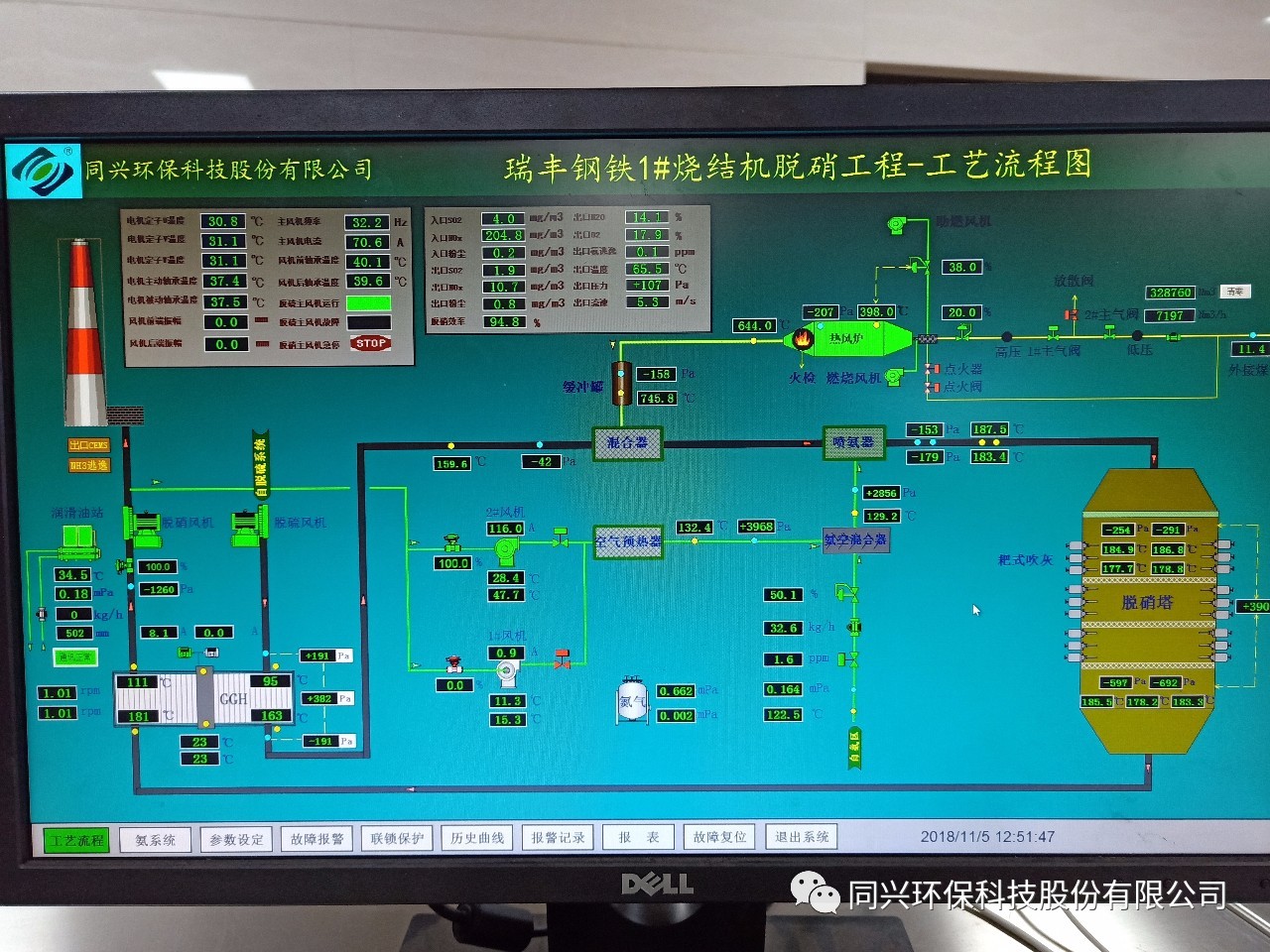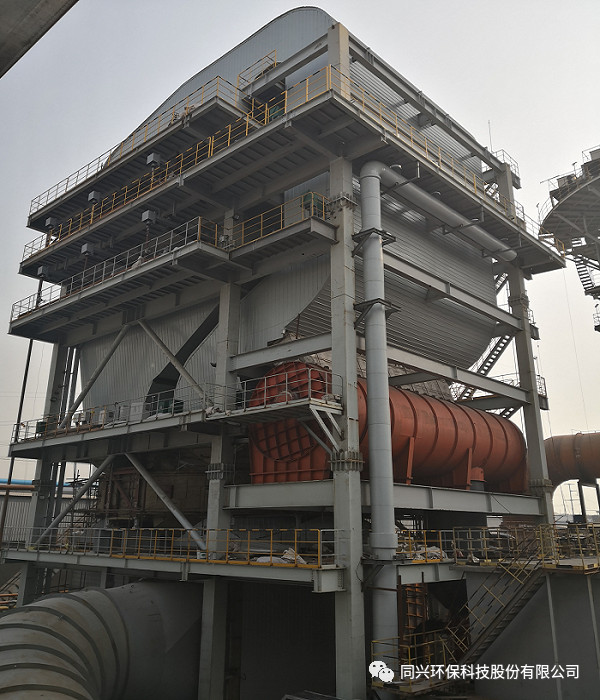Tongxing Environmental Protection: The world's first sintering flue gas 180 ℃ SCR denitrification project has been successfully put into operation
Publishdate:2018-11-13 Views:78
The 180 ℃ low-temperature SCR denitrification project of the flue gas from the sintering machines 1 # and 3 # of Tangshan Ruifeng Iron and Steel (Group) Co., Ltd. is contracted by Tongxing Environmental Protection Technology Co., Ltd. EPC. On October 24, 2018, the secondary flue gas entered the thermal load linkage test, and was successfully put into operation on November 2, 2018, meeting the standards.
According to the central control screen and historical data, there are two layers of catalyst filled in the denitrification reactor. The temperature of the first layer of catalyst bed is 184.9 ℃, and the temperature of the second layer of catalyst bed is 178.2 ℃. The general inlet NOx of the denitrification reactor is 200-300 mg/Nm ³, Stable export NOx at 20 mg/Nm ³ Below. By adjusting the ammonia injection rate, the outlet NOx can be stabilized at 5mg/Nm ³ Below, ammonia escape is ≤ 1ppm, and the emission concentration is far lower than the local standard requirement of 50mg/Nm in Hebei Province ³ The emission concentration has preliminarily verified the adaptability and feasibility of the low-temperature SCR denitrification process on sintering flue gas, which can fully achieve ultra-low emissions of NOx in sintering flue gas and even near zero emissions in the future.
According to the data analysis since its operation, using 180 ℃ low-temperature denitrification has a great potential for saving gas consumption. Through on-site temperature regulation, the catalyst can be used for denitrification at different temperatures, and the gas consumption is as follows: (The flue gas volume is about 700000-840000 Nm3/h)
1. The GGH raw flue gas outlet is raised from 155 ° C to 180 ° C (denitrification temperature), and the gas consumption is 7835Nm3/h;
2. The GGH raw flue gas outlet is raised from 220 ℃ to 250 ° C (denitrification temperature), and the gas consumption is 15778Nm3/h;
Explanation: GGH is selected and designed according to the low-temperature catalyst analysis temperature of 250 ℃
According to the market price of blast furnace gas calculated at 0.1 yuan/cubic meter, the denitrification catalyst with a reaction temperature of 180 ℃ saves approximately 6.958 million yuan/year compared to the denitrification cost at 250 ℃, fully proving that low-temperature SCR denitrification of sintered flue gas has significant energy-saving effects.
According to the on-site management personnel and relevant experts of Ruifeng Iron and Steel Group, the low-temperature SCR denitrification projects of sintering flue gas 1 # and 3 # have the following outstanding advantages:
1. At present, this is the successful application of low-temperature SCR technology in sintering machine flue gas purification within the scope, and the denitrification efficiency reaches over 95% at an operating temperature of 180 ℃.
2. By adopting a low-temperature denitrification process, the amount of flue gas under the same standard conditions entering the SCR denitrification reactor for treatment is relatively small, resulting in a decrease in system temperature. The low-temperature drop can be controlled within 2 ℃, reducing gas consumption to a certain extent and lowering operating costs.
3. By adopting low-temperature SCR denitrification, the amount of flue gas in the treatment condition of GGH heat exchanger is greatly reduced, the diameter of GGH is reduced, and the secondary investment of GGH is greatly reduced.
 1 # sintering machine industrial control computer screen
1 # sintering machine industrial control computer screen
Tangshan Ruifeng Iron and Steel (Group) Co., Ltd.'s 1 # and 3 # sintering machines are both 200 square meters, with an annual output of 1.7 million tons of sintered ore. The flue gas purification adopts the process of "semi dry desulfurization+GGH heat exchange (cold side)+flue gas heating+low-temperature SCR denitrification (180 ℃)+GGH heat exchange (hot side)+induced draft fan+original chimney discharge". Design smoke volume 840000 Nm ³/ h. The inlet flue gas temperature of GGH heat exchange (cold side) is 75-95 ℃, and the designed NOx at the inlet of the denitrification system should not exceed 450 mg/Nm3. The NOx emission concentration at the outlet of the denitrification system should be less than 50 mg/Nm3. The SCR catalyst for this process uses the "Fangxin" low-temperature catalyst developed by Beijing Fangxin Lihua Technology Co., Ltd., a subsidiary of Tongxing Environmental Protection. The official ammonia injection operation of Tangshan Ruifeng Iron and Steel (Group) Co., Ltd.'s 1 # and 3 # sintering flue gas low-temperature SCR denitrification projects marks a successful industry breakthrough for "Fangxin" low-temperature catalyst in low-temperature SCR denitrification of sintering flue gas. This is a new breakthrough for "Fangxin" low-temperature catalysts in industries such as coking, waste incineration, cement, glass, ceramics, refractory, papermaking, alumina, acid washing, tunnel kiln, etc.
It is reported that in addition to the operation of SCR denitrification for sintering flue gas at Tangshan Ruifeng Iron and Steel 1 # and 3 #, Tongxing Environmental Protection is also general contracting for 8 sets of sintering flue gas SCR denitrification projects, including Ruifeng Iron and Steel 2 #, 4 #, 5 #, 6 #, 7 #, Songting Iron and Steel, Jingye Iron and Steel, and Ausen Iron and Steel, which are under intense construction. With the successive operation of these projects, Tongxing Environmental Protection has achieved full coverage of "wet flue gas desulfurization+medium and low temperature SCR denitrification" and "semi dry flue gas desulfurization+medium and low temperature SCR denitrification" process technologies in the domestic sintering machine flue gas low-temperature SCR denitrification field, and seamless integration of sintering flue gas desulfurization process and SCR denitrification process, greatly boosting confidence in achieving ultra-low emissions in non electric flue gas low-temperature denitrification, This provides strong technical support for the ultra-low emission transformation of non electric areas in Hebei Province and even the whole country.

The 180 ℃ low-temperature SCR denitrification project of the flue gas from the sintering machines 1 # and 3 # of Tangshan Ruifeng Iron and Steel (Group) Co., Ltd. is contracted by Tongxing Environmental Protection Technology Co., Ltd. EPC. On October 24, 2018, the secondary flue gas entered the thermal load linkage test, and was successfully put into operation on November 2, 2018, meeting the standards.
According to the central control screen and historical data, there are two layers of catalyst filled in the denitrification reactor. The temperature of the first layer of catalyst bed is 184.9 ℃, and the temperature of the second layer of catalyst bed is 178.2 ℃. The general inlet NOx of the denitrification reactor is 200-300 mg/Nm ³, Stable export NOx at 20 mg/Nm ³ Below. By adjusting the ammonia injection rate, the outlet NOx can be stabilized at 5mg/Nm ³ Below, ammonia escape is ≤ 1ppm, and the emission concentration is far lower than the local standard requirement of 50mg/Nm in Hebei Province ³ The emission concentration has preliminarily verified the adaptability and feasibility of the low-temperature SCR denitrification process on sintering flue gas, which can fully achieve ultra-low emissions of NOx in sintering flue gas and even near zero emissions in the future.
According to the data analysis since its operation, using 180 ℃ low-temperature denitrification has a great potential for saving gas consumption. Through on-site temperature regulation, the catalyst can be used for denitrification at different temperatures, and the gas consumption is as follows: (The flue gas volume is about 700000-840000 Nm3/h)
1. The GGH raw flue gas outlet is raised from 155 ° C to 180 ° C (denitrification temperature), and the gas consumption is 7835Nm3/h;
2. The GGH raw flue gas outlet is raised from 220 ℃ to 250 ° C (denitrification temperature), and the gas consumption is 15778Nm3/h;
Explanation: GGH is selected and designed according to the low-temperature catalyst analysis temperature of 250 ℃
According to the market price of blast furnace gas calculated at 0.1 yuan/cubic meter, the denitrification catalyst with a reaction temperature of 180 ℃ saves approximately 6.958 million yuan/year compared to the denitrification cost at 250 ℃, fully proving that low-temperature SCR denitrification of sintered flue gas has significant energy-saving effects.
According to the on-site management personnel and relevant experts of Ruifeng Iron and Steel Group, the low-temperature SCR denitrification projects of sintering flue gas 1 # and 3 # have the following outstanding advantages:
1. At present, this is the successful application of low-temperature SCR technology in sintering machine flue gas purification within the scope, and the denitrification efficiency reaches over 95% at an operating temperature of 180 ℃.
2. By adopting a low-temperature denitrification process, the amount of flue gas under the same standard conditions entering the SCR denitrification reactor for treatment is relatively small, resulting in a decrease in system temperature. The low-temperature drop can be controlled within 2 ℃, reducing gas consumption to a certain extent and lowering operating costs.
3. By adopting low-temperature SCR denitrification, the amount of flue gas in the treatment condition of GGH heat exchanger is greatly reduced, the diameter of GGH is reduced, and the secondary investment of GGH is greatly reduced.
 1 # sintering machine industrial control computer screen
1 # sintering machine industrial control computer screen
Tangshan Ruifeng Iron and Steel (Group) Co., Ltd.'s 1 # and 3 # sintering machines are both 200 square meters, with an annual output of 1.7 million tons of sintered ore. The flue gas purification adopts the process of "semi dry desulfurization+GGH heat exchange (cold side)+flue gas heating+low-temperature SCR denitrification (180 ℃)+GGH heat exchange (hot side)+induced draft fan+original chimney discharge". Design smoke volume 840000 Nm ³/ h. The inlet flue gas temperature of GGH heat exchange (cold side) is 75-95 ℃, and the designed NOx at the inlet of the denitrification system should not exceed 450 mg/Nm3. The NOx emission concentration at the outlet of the denitrification system should be less than 50 mg/Nm3. The SCR catalyst for this process uses the "Fangxin" low-temperature catalyst developed by Beijing Fangxin Lihua Technology Co., Ltd., a subsidiary of Tongxing Environmental Protection. The official ammonia injection operation of Tangshan Ruifeng Iron and Steel (Group) Co., Ltd.'s 1 # and 3 # sintering flue gas low-temperature SCR denitrification projects marks a successful industry breakthrough for "Fangxin" low-temperature catalyst in low-temperature SCR denitrification of sintering flue gas. This is a new breakthrough for "Fangxin" low-temperature catalysts in industries such as coking, waste incineration, cement, glass, ceramics, refractory, papermaking, alumina, acid washing, tunnel kiln, etc.
It is reported that in addition to the operation of SCR denitrification for sintering flue gas at Tangshan Ruifeng Iron and Steel 1 # and 3 #, Tongxing Environmental Protection is also general contracting for 8 sets of sintering flue gas SCR denitrification projects, including Ruifeng Iron and Steel 2 #, 4 #, 5 #, 6 #, 7 #, Songting Iron and Steel, Jingye Iron and Steel, and Ausen Iron and Steel, which are under intense construction. With the successive operation of these projects, Tongxing Environmental Protection has achieved full coverage of "wet flue gas desulfurization+medium and low temperature SCR denitrification" and "semi dry flue gas desulfurization+medium and low temperature SCR denitrification" process technologies in the domestic sintering machine flue gas low-temperature SCR denitrification field, and seamless integration of sintering flue gas desulfurization process and SCR denitrification process, greatly boosting confidence in achieving ultra-low emissions in non electric flue gas low-temperature denitrification, This provides strong technical support for the ultra-low emission transformation of non electric areas in Hebei Province and even the whole country.





